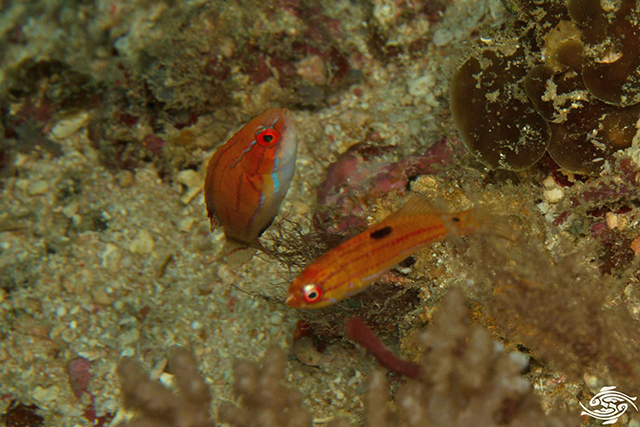| Labridae (Wrasses) |
| 5.95 cm SL (male/unsexed) |
|
demersal; marine; depth range 21 - 50 m |
| Western Indian Ocean: known only from one atoll of the Amirante Islands in Seychelles and one specimen from the aquarium trade from Kenya. |
|
Dorsal spines (total): 9-9; Dorsal soft rays (total): 11-11; Anal spines: 3-3; Anal soft rays: 9-9; Vertebrae: 25-25. Median predorsal scales 5; horizontal scale rows on cheek below eye 2; body depth 3.2-3.55 in SL; ; head length 2.9-3.05 in SL; snout length 3.9-4.1 in HL; first dorsal soft ray of adults long and filamentous; caudal fin rounded in young, lanceolate with strongly concave upper and lower posterior margin in adults, the fin length 2.9-3.6 in SL; pelvic fin short, 1.6-1.8 in HL. Adult males in life light orange, shading to yellow ventrally, with four longitudinal lavender bands on body which link to three narrow lavender bands extending posteriorly from eye; dorsal fin yellow with a broad blue-edged red zone posteriorly in fin, the filament red. Small females with the same but narrower stripes, dark-edged blue lines dorsally on head, a large dark brown spot at base of dorsal fin below juncture of spinous and soft portions, and a small dark brown spot dorsoposteriorly on caudal peduncle. |
| Found over rubble or hard bottom (Ref. 41634). Largest size recorded is 6.58 mm SL from the aquarium trade (Ref. 41634). |
|
Least Concern (LC); Date assessed: 25 March 2009 Ref. (130435)
|
| harmless |
Source and more info: www.fishbase.org. For personal, classroom, and other internal use only. Not for publication.

